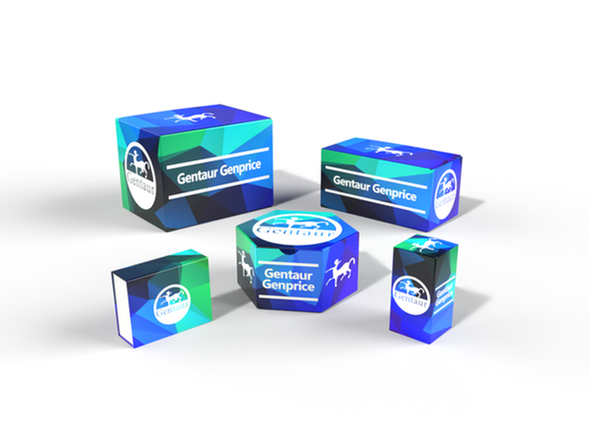Description
TIGIT Antibody [2F7] | SD8827 | Gentaur UK, US & Europe Distribution
Host: Llama
Reactivity: Human
Homology: N/A
Immunogen: TIGIT antibody was raised against a recombinant protein corresponding to amino acids 22-141 of human TIGIT.
Research Area: Immunology
Tested Application: E, IHC-P, ICC, IF, Flow
Application: TIGIT antibody can be used for ELISA starting at 0.1 μg/mLimmunohistochemistry starting at 10 μg/mL. For immunofluorescence start at 20 μg/mL. For flow cytometry at 1 μg/ml. For immunocytochemistry at 10μg/mL.
Specificiy: N/A
Positive Control 1: N/A
Positive Control 2: N/A
Positive Control 3: N/A
Positive Control 4: N/A
Positive Control 5: N/A
Positive Control 6: N/A
Molecular Weight: N/A
Validation: N/A
Isoform: N/A
Purification: TIGIT Antibody is affinity chromatography purified via Nickel column. Antibody is supplied as a His-tagged purified protein. It also contains a myc-tag for detection.
Clonality: Recombinant Monoclonal
Clone: 2F7
Isotype: sdAb
Conjugate: Unconjugated
Physical State: Liquid
Buffer: TIGIT Antibody is supplied in PBS.
Concentration: 1 mg/mL
Storage Condition: TIGIT antibody should be stored in working aliquots at -20˚C, stable for up to one year. As with all antibodies care should be taken to avoid repeated freeze thaw cycles. Antibodies should not be exposed to prolonged high temperatures.
Alternate Name: TIGIT Antibody: T-cell immunoreceptor with Ig and ITIM domains, VSIG9, VSTM3, WUCAM
User Note: Optimal dilutions for each application to be determined by the researcher.
BACKGROUND: TIGIT Antibody: The T cell immunoreceptor with Ig and ITIM domains (TIGIT) is a member of the PVR (poliovirus receptor) family of immunoglobin proteins. It is expressed on several classes of T cells including follicular B helper T cells (TFH). TIGIT has been shown to bind PVR with high affinity; this binding is thought to assist interactions between TFH and dendritic cells to regulate T cell dependent B cell responses (1). Similar to other immune checkpoint proteins such as PD-1, TIGIT is upregulated on exhausted T cells in chronic viral infections and cancer. Blockade of both TIGIT and PD-1 pathways leads to tumor rejection in mice suggesting that it may be of therapeutic use against cancer (2).

![TIGIT Antibody [2F7] | SD8827 TIGIT Antibody [2F7] | SD8827](https://cdn11.bigcommerce.com/s-1rdwiq712m/images/stencil/608x608/products/458735/464563/gentaur-genprice__26005.1661610467__29809.1661628092__75433.1661676199__77988.1661684280__64362.1661692443__02085.1662049603__45075.1662119302__91744.1662191540__21580.1662291419__03144.1663493568.png?c=1)
![CD81 Antibody [2F7] CD81 Antibody [2F7]](https://cdn11.bigcommerce.com/s-1rdwiq712m/images/stencil/590x590/products/485086/490915/gentaur-genprice__26005.1661610467__29809.1661628092__75433.1661676199__77988.1661684280__64362.1661692443__02085.1662049603__45075.1662119302__91744.1662191540__21580.1662291419__27238.1663498975.png?c=1)
![TIGIT Antibody [ApR05009G] TIGIT Antibody [ApR05009G]](https://cdn11.bigcommerce.com/s-1rdwiq712m/images/stencil/590x590/products/61252/61556/gentaur-genprice__26005.1661610467__29809.1661628092__75433.1661676199__77988.1661684280__64362.1661692443__35900.1661864114.png?c=1)
![CD81 Antibody [2F7] CD81 Antibody [2F7]](https://cdn11.bigcommerce.com/s-1rdwiq712m/images/stencil/590x590/products/485089/490918/gentaur-genprice__26005.1661610467__29809.1661628092__75433.1661676199__77988.1661684280__64362.1661692443__02085.1662049603__45075.1662119302__91744.1662191540__21580.1662291419__53096.1663498975.png?c=1)
![GSTA1 Antibody [2F7] GSTA1 Antibody [2F7]](https://cdn11.bigcommerce.com/s-1rdwiq712m/images/stencil/590x590/products/486592/492421/gentaur-genprice__26005.1661610467__29809.1661628092__75433.1661676199__77988.1661684280__64362.1661692443__02085.1662049603__45075.1662119302__91744.1662191540__21580.1662291419__74403.1663499216.png?c=1)


![CD81 Antibody [2F7] (APC) CD81 Antibody [2F7] (APC)](https://cdn11.bigcommerce.com/s-1rdwiq712m/images/stencil/590x590/products/484609/490438/gentaur-genprice__26005.1661610467__29809.1661628092__75433.1661676199__77988.1661684280__64362.1661692443__02085.1662049603__45075.1662119302__91744.1662191540__21580.1662291419__30609.1663498898.png?c=1)
![CD81 Antibody [2F7] (FITC) CD81 Antibody [2F7] (FITC)](https://cdn11.bigcommerce.com/s-1rdwiq712m/images/stencil/590x590/products/485087/490916/gentaur-genprice__26005.1661610467__29809.1661628092__75433.1661676199__77988.1661684280__64362.1661692443__02085.1662049603__45075.1662119302__91744.1662191540__21580.1662291419__63910.1663498975.png?c=1)
![TIGIT Antibody [4A11] TIGIT Antibody [4A11]](https://cdn11.bigcommerce.com/s-1rdwiq712m/images/stencil/590x590/products/460915/466744/gentaur-genprice__26005.1661610467__29809.1661628092__75433.1661676199__77988.1661684280__64362.1661692443__02085.1662049603__45075.1662119302__91744.1662191540__21580.1662291419__74173.1663494814.png?c=1)